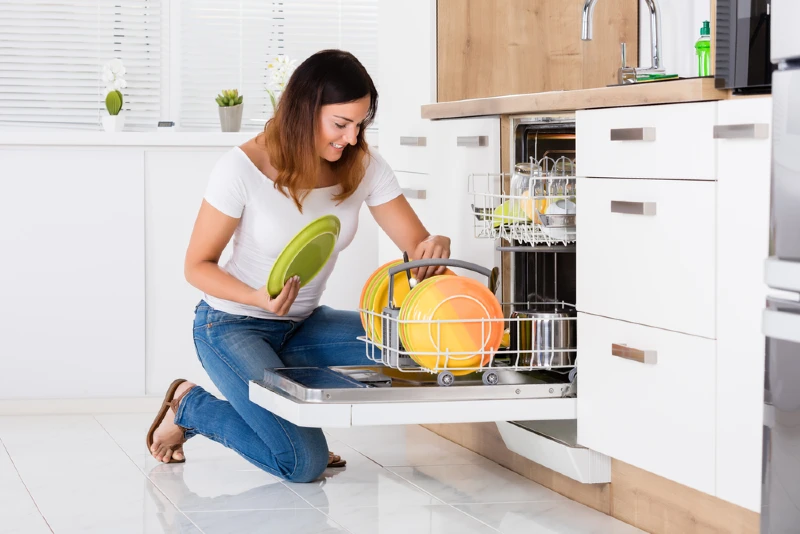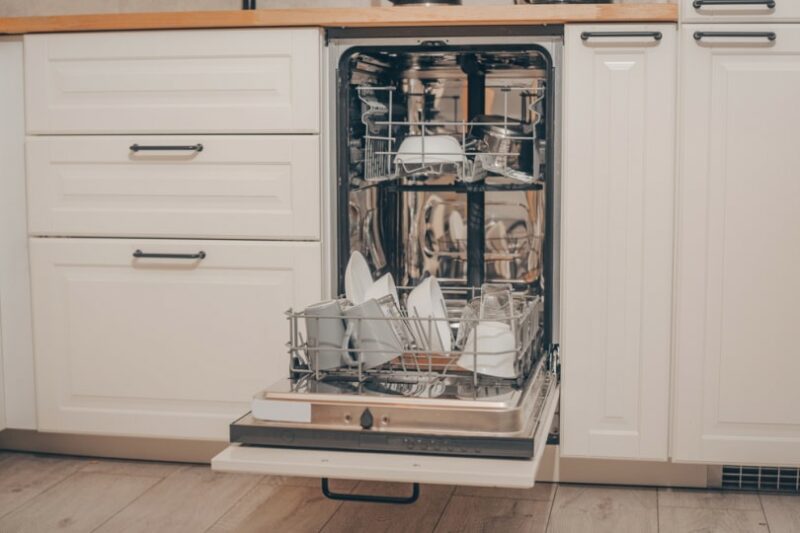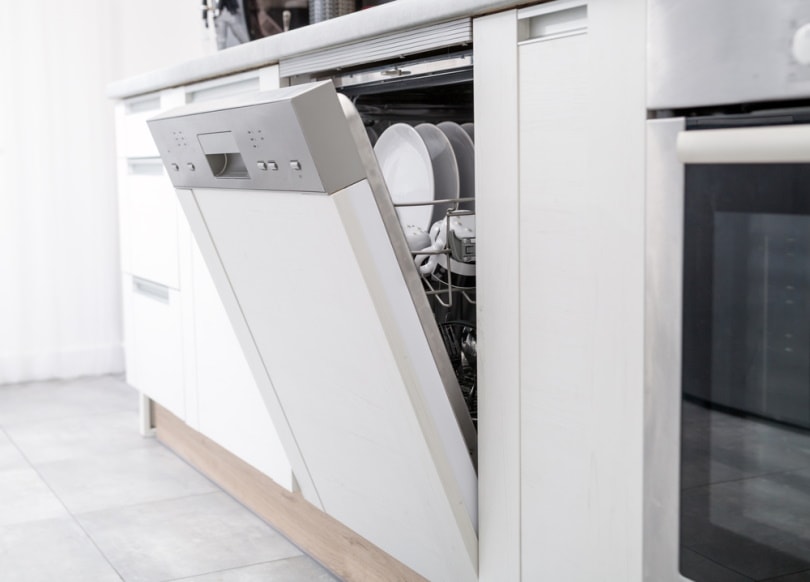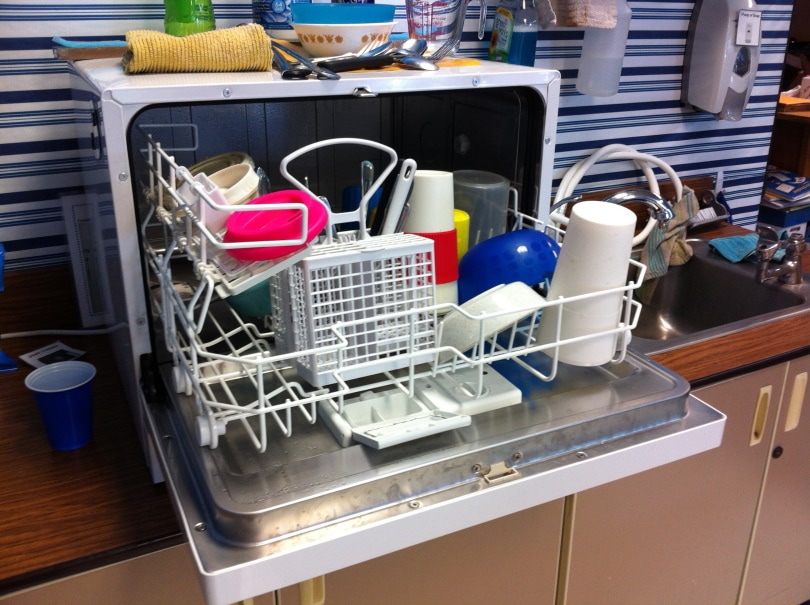How Do Dishwashers Work? What You Should Know
-
Pete Ortiz
- Last updated:

Handwashing dishes can be a tedious chore, and if you are an avid host of dinner parties, you may feel like it’s time to add a dishwasher to your kitchen. Thanks to the invention of the dishwasher, this chore can be a thing of the past.
A Dishwasher can add convenience to your life, save time, and give you peace of mind knowing that your dishes are clean and disinfected. If you already own one, it may seem like a magic box the way that your dishes come out sparkling clean, which may have you wondering how they work and what happens inside. In this article, we’ll explain the basic parts of a dishwasher and how it gets the job done.
How Does a Dishwasher Work?
A dishwasher can detect the air and water temperature, preventing it from overheating and damaging your dishes. The machine can prevent water from overflowing by activating a draining function if the water levels get too high, and some are smart enough to detect just how clean your dishes are.
A small basin at the bottom of the dishwasher fills up with water which gets heated up and mixed with detergent. It is then pumped up and sprayed through rotating spray arms with enough force to clean the dirty dishes. The food particles are collected in a filter, and the cycle repeats itself a few times.
Once the cycles are completed, the water will drain back into the basin, and a pump will dispose of it either into the pipes below your sink or the garbage disposal. Some dishwashers also include a dry cycle. This cycle activates when the heating elements heat the air inside the dishwasher, allowing the dishes to dry.
What Are the Main Parts of a Dishwasher?
Control Pad: The control pad is used to control settings and options and is usually located on the top or front of the machine. The control panel will also display error messages.
Heating Element: The heating element is usually located at the bottom of the dishwasher. It is responsible for heating the water during the wash cycle and the air during the drying cycle.
Detergent Dispenser: Before starting a cycle, the dish detergent and rinse aid are stored in the detergent dispenser located inside the dishwasher. It will release the detergent at a suitable time during the wash cycle.
Spray Arms: A typical dishwasher has two rotating wash arms, and some higher-end models may have a third ceiling arm. One arm is beneath the upper rack, and one is beneath the lower rack, and when water from the circulation pump enters the arms, both will activate.
Water Intake Valve: The valve allows water to enter the machine from the home’s water supply. It will open and close, allowing the correct amount of water to enter during the cycle.
Circulation Pump: The pump is powered by an electric motor that forces water into the spray arms.
Filtration System: The filter is usually located below the lower rack at the bottom of the machine. It filters out dirty water while preventing the pump from becoming clogged by food particles.
What Are the Different Types of Dishwashers?
There are numerous dishwasher styles available, and choosing the right model can help you save time and effort while keeping your kitchen running efficiently.
1. Compact Dishwasher

A compact dishwasher is smaller than a standard dishwasher, making it ideal for small apartments or offices. They are usually 18 inches wide, 34–36 inches tall, and 24 inches deep.
2. Freestanding Dishwasher

A freestanding dishwasher is ideal if you have a bit more space available. They include front-control dishwashers and top-control dishwashers.
3. Integrated Dishwasher

Integrated dishwashers are the same size as freestanding dishwashers but are installed under the counter. They are suitable for smaller kitchens. These built-in dishwashers are aesthetically pleasing as they are usually hidden behind a cabinet door.
4. Portable Dishwasher

Portable dishwashers can be stored and used as they are needed. They are not fixed to your plumbing but can attach to the tap and drain into the sink. Some models are available in the same size as a standard dishwasher, while some are small enough to fit on the countertop.
 Using a Dishwasher
Using a Dishwasher
A dishwasher can effectively clean and sanitize your dishes, but there are a few guidelines you should follow to help you run your dishwasher smoothly.
- Don’t overload your dishwasher.
- Don’t use regular dish soap since it can overflow your dishwasher.
- Direct your dirtiest dishes toward the jet sprays.
- Separate dishes that are the same shape so they don’t clump together, making it hard for the water to reach.
- Use your dishwasher during a time when water pressure is high. For example, don’t use your dishwasher while washing your clothes, as the water pressure won’t be as strong.
- Avoid putting plastic on the bottom rack close to the heating element.
- Use slightly more detergent if your home has hard water.
- Convenient
- Time-saving
- More hygienic
- Keeps dirty dishes out of sight
- You can regulate the amount of electricity and water that you use
- Takes up a large amount of space in your kitchen
- Some brands use more water
- They require power to run as opposed to handwashing
- Not all dishes can go in the dishwasher
- Owning a dishwasher means you have another appliance that needs care and maintenance
Frequently Asked Questions (FAQs)
Is a Dishwasher Worth Buying?
Dishwashers are worth purchasing because of their cost and energy efficiency. They are ideal for large families and individuals who lack the time or loathe washing dishes.
Does It Matter What Detergent I Use?
Your detergent should work in tandem with your dishwasher’s cleaning action. Dishwashing detergent for automatic machines is specially formulated to diffuse food residue and grease, keep it suspended, and remove it in the final rinse while producing little to no suds. It is best to use the detergent recommended by your machine’s manufacturer.

Do I Need to Pre-rinse My Dishes?
There’s no need to pre-rinse. Although many households do it, it is time-consuming and wastes valuable resources. Modern detergents contain bleach and enzymes, and dishwasher manufacturers recommend using them without pre-rinsing.
How Do Dishwasher Tablets Work?
Surfactants in dishwasher tablets affect the liquid they are added to, making them more effective at picking up and washing away particles. They include enzymes to break down starchy foods and protein, builders to deal with hard water and safe bleaches.
Do Dishwashers Use a lot of Electricity?
The primary electricity consumption of a dishwasher is pleasantly low. You use 1.2 kilowatt-hours (kWh) for a 1200-watt model and a load time of 1 hour, which is about 12 cents per load on a 10-cent per kWh electricity plan.
Are There Items That Shouldn’t Go into a Dishwasher?
There are a few items that you should avoid putting in your dishwasher, such as vintage materials, crystal, hand-painted ceramics, cast iron, copper items, sharp knives, and cheese graters.
Conclusion
A dishwasher is engineered with sensors and mechanisms to control water levels and temperatures while dispensing the right amount of water and detergent at the right time. All you need to do is load your dishes and let the dishwasher do the work. Surprisingly, a dishwasher can save energy and water, more so than hand washing, and best of all, it saves you time and is highly effective at cleaning your dishes.
Featured Image Credit: Andrey_Popov, Shutterstock
Contents


 Using a Dishwasher
Using a Dishwasher